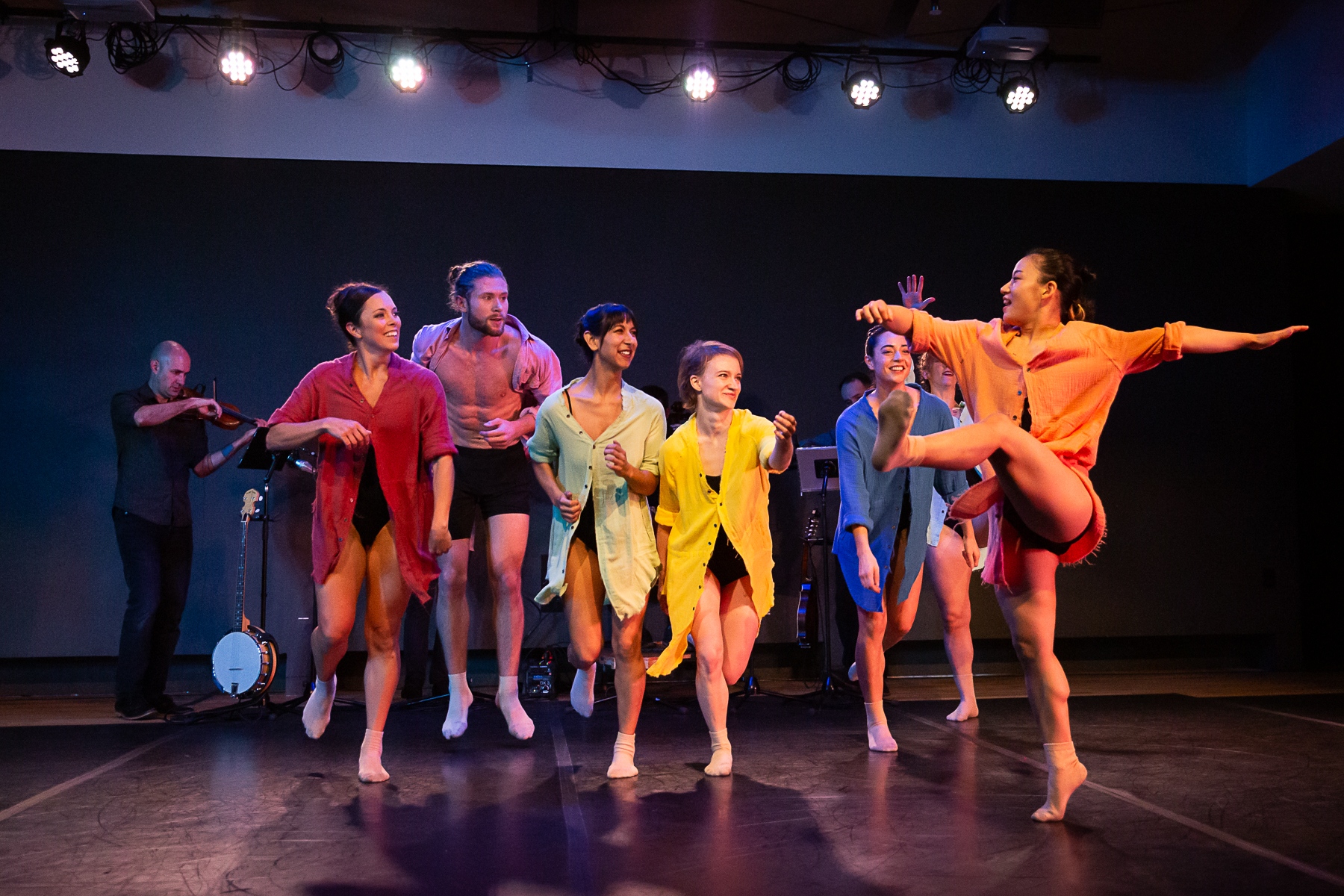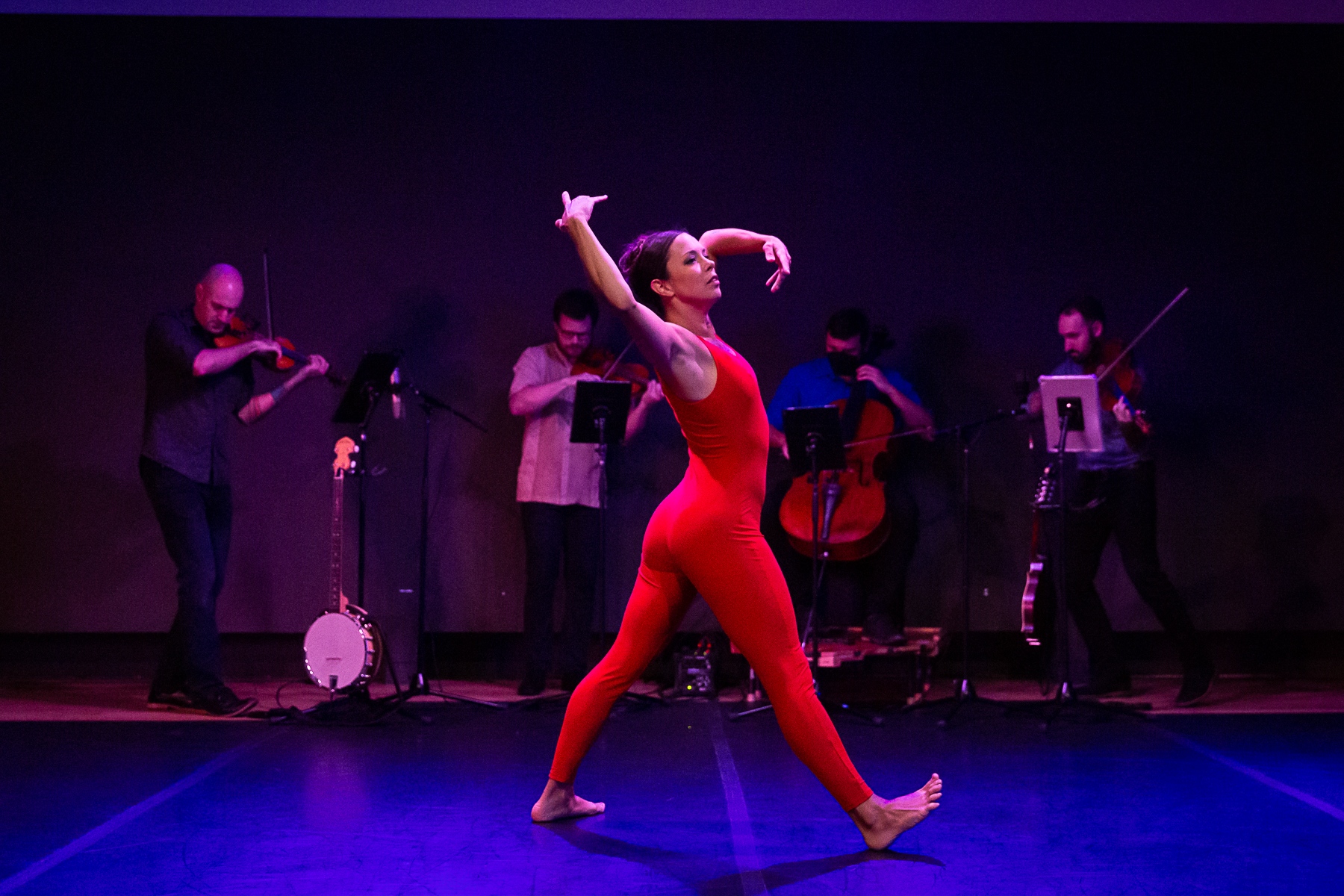Review: Kaleidoscope (2024) by Ventana Ballet and Austin Camerata
by David Glen Robinson
Kaleidoscope is a collaboration between Ventana Ballet and Austin Camerata music, but duality has little to do with it. In Kaleidoscope, each click-twist of the tube tumbled every movement and note into new intersections and visions of dance and modern music, never to be repeated exactly in the world of art. This quality placed a high premium on the eye-witness experience, well worth the ticket.
The Draylen Mason Music Studio in the KMFA studios is a remarkable facilitator of music and dance. The space looks wider than deep, acoustics near perfect, wired for sound and video, sprung wood/composite flooring, climate controlled. A major quality, highlighted in the after-show talk, is that the vibrations arising from the stringed instruments propagate through the floor into the bodies of the musicians, dancers, and the audience. This was another subtle yet palpable means of sharing the live experience.

Ventana Ballet and Austin Camerata took full advantage of the space. Austin Camerata offered a string quartet to play works of modern music in showcase and as accompaniment to the dance pieces. AJ Garcia-Rameau, artistic director of Ventana Ballet, and Daniel Kopp, artistic director of Austin Camerata, took several months to organize and produce Kaleidoscope, following from last year’s Kaleidoscope. One hopes the show will continue anually as a lengthy series.
This year’s edition gave us ten pieces, six of dance with musical accompaniment and four of music by the string ensemble without dancers. Kopp played cello, with an ensemble including Sean Riley and Carter Coleman, violins, and Luis Bellorin, viola. This skilled and confident group played works by Michael Nyman, Philip Glass, Alexander Balanescu, Rhiannon Giddens, Andrea Casarubios, Paul Wiancko, Max Richter, Giovanni Sollima, Basilius Alawad, and Aleksandra Vrebalov. As Kopp advised us in his pre-show curtain speech, all these are living composers. The life status of composers seems to be a persistent issue these days.
Tikiri Shapiro’s “The Joy of a New Perspective” took the bold front lead-off position. Six dancers filled the stage with expansive energy and their demonstration of ballet technique. Their unison and cohesion seemed unbroken throughout. Breaking apart and joining together was well-cued (i.e., invisible to observers). The dance was on a theme on Plato’s Cave—illusions behind us, possibilities ahead of us, ever to build reality. Lillie Amdahl, Elizabeth Coleman, Caitlin Elledge, Elaine Fields, Ripley Mayfield, and Tikiri Shapiro danced.
Kanami Nakabayashi’s entrance as the arctic hare in Navaji David Nava’s “Rainbow Crow” was one of heart-stopping beauty, continuing into an introductory solo in her white-on-white costume ass arctic hare in winter. Four other dancers entered similarly, each costumed as an animal of the boreal zone. The last to was Navaji David Nava as a crow, but one oddly wearing colored feathers. The piece retold in ballet a Native American myth on how fire was brought into the world. Navaji and the performers told all of it in movement, entirely without pantomime (a bit of verbal introduction came later). The time was the Ice Age, and the world was getting colder and darker. Versions of this story vary widely. The animals pleaded for help fo they were dying. Crow volunteered to fly upward to find help. Help was the Great Spirit, who could alleviate the suffering, but there would be a price. Crow accepted the charge. The Great Spirit gave Crow a coal to take back to propagate warmth. Crow took it with his beak (some stories say in his stomach) and returned. He gave the coal to the animals and saved them, but the cost was terrible: he was blackened forever, and his voice was damaged and distorted. The Great Spirit’s heart softened at Crrow's suffering borne by Crow, so it granted Crow special blessings. When humans came into the world, Crow, unlike the others, would be immune from their intrusions, notably hunting. That was a great relief. In some stories, Crow and the tribe of crows were given an additionnal high responsibility: they would ever after carry off the souls of human dead, presumably to the Great Spirit.
“Rainbow Crow” is one of the front rank of new ballets sourced in folklore and myth from around the world. It shares this trend with Ballet Austin II’s Maria and the Mouse Deer, which originated in Philippine and Southeast Asian folklore. These and similarr works of art are actively enriching world culture and are welcome. Told with animal characters dancing ballet, “Rainbow Crow,” danced by Lillie Amdahl, Elaine Fields, AJ Garcia-Rameau, Kanami Nakabayashi, and Navaji David Nava, warned of environmental crisis and portrayed right doing, heroism, sacrifice, and physical and spiritual redemption.

“Floating” by AJ Garcia-Rameau gave us a short trio on the sensation of floating above the clouds. As always, Garcia-Rameau’s dances display exquisite technique and convey great feeling. Far more abstract than “Rainbow Crow,” the piece nevertheless conveyed the feeling of flying/floating at great heights. The performers were Rachel Cox Culver, Ripley Mayfield, and Tikiri Shapiro.
“Bound,” choreographed by Ty Graynor, another standout ballet dance piece. Ty Graynor and Meggie Belisle performed the duet, the kind we see but rarely. Duets are always about relationships—strong, weak, or falling apart—but this one was about the passion of relationships waxing and waning, growing and weakening, but always coming back and staying together, though perhaps with different dynamics. The dance portrayed the rollercoaster of passion and holding on to same with an athletic grip. With that grip, the performers could execute spinning, star-wheeling lifts descending to rolling floor work and stillnesses. The audience exhaled audibly at the end of the piece. Ty Graynor has danced much in Austin since arriving in 2022 in various dance modes including the ballet duet. Meggie Belisle is a lithe, experienced dancer with international training and credits. She performed with Graynor in his From Inferno to Americana last year.
.png) The penultimate live dance piece was “The Nightmare,” the piece with the greatest claim to uniqueness. Choreographed by AJ Garcia-Rameau, it was a duet between her and Daniel Kopp of Austin Camerata. He sat in a chair and played the cello while she played her perfected ballet technique all around him. With his eyes closed, Kopp played “The Nightmare,” composed by Basilius Alawad. With that prompt, it was easy to imagine the sleeping room of Kopp invaded by a spirit, loving or malign at different times. She rode the rolling clouds of dream as he played. An odd moment of drama built quickly at one point when she approached him and lightly ran her fingers down his arm as he drew the bow slowly across the strings. The peformance evoked two intersections with other modes of art: the painting “The Nightmare” by Henry Fuseli and, in distant undertones, Poe’s poem “The Raven.” If “The Nightmare” was an experiment, it was a very successful one.
The penultimate live dance piece was “The Nightmare,” the piece with the greatest claim to uniqueness. Choreographed by AJ Garcia-Rameau, it was a duet between her and Daniel Kopp of Austin Camerata. He sat in a chair and played the cello while she played her perfected ballet technique all around him. With his eyes closed, Kopp played “The Nightmare,” composed by Basilius Alawad. With that prompt, it was easy to imagine the sleeping room of Kopp invaded by a spirit, loving or malign at different times. She rode the rolling clouds of dream as he played. An odd moment of drama built quickly at one point when she approached him and lightly ran her fingers down his arm as he drew the bow slowly across the strings. The peformance evoked two intersections with other modes of art: the painting “The Nightmare” by Henry Fuseli and, in distant undertones, Poe’s poem “The Raven.” If “The Nightmare” was an experiment, it was a very successful one.
The final piece in the show was “Intersections,” tipping us, as if we didn’t already know, that the notion of intersections was a dominant theme in its music and dance. A video was shown on the large screen upstage as preface to the live dance choreographed by Garcia-Rameau,. The scene seemed to depict a rehearsal and interview with Aleksandra Vrebalov, composer of the accompanying music, “My Desert, My Rose.” She discussed her musical piece, then a picked up a largish colorful abstract painting. She called it a sketch she made of the musicians playing her composed work. She pointed out the points in the music where she applied paint, starting on the left and working up to the energetic climax at the end, to the right. OMG. Is this a self-reflexive intersection occurring in the creative chambers of one very talented person’s mind? One then offered out to the world via video and music?
Garcia-Rameau’s live dance at the end of a show featured many intersections. It seemed calmly reflective and thoughtful, expressed in ballet movement by five strong and highly skilled dancers of the company. Ballet and music have always been well intersected, given Petipa/Tchaikovsky, Diaghilev/Stravinsky, and doubtless many others, but as we look to the future, we have and project many other modes of connection. The crisp, smooth movements and patterns of Garcia-Rameau’s dancers express confidence in the validity of the patterrns shown here in visual art, mythology, and the state-of-the-art lighting and sound of KMFA's Draylen Mason Music Studio. The dancers of “Intersections” were Elizabeth Coleman, Rachel Cox Culver, Caitlin Elledge, AJ Garcia-Rameau, and Kanami Nakabayashi.
Again, one hopes Kaleidoscope will become a lengthy annual series. While you are waiting (for a whole year!), follow Ventana Ballet and Austin Camerata on social media for other shows these highly creative fine arts entities will surely produce.
Kaleidoscope (2024)
by Ventana Ballet
Ventana Ballet
May 23 - May 26, 2024
May 23 - 26, 2024
KMFA Draylen Mason Studios, Austin
